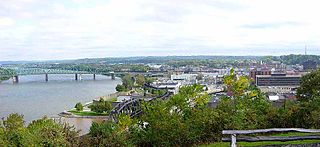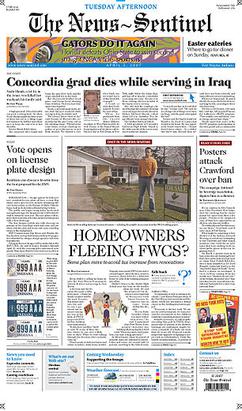Related Research Articles

Parkersburg is a city in and the county seat of Wood County, West Virginia, United States. Located at the confluence of the Ohio and Little Kanawha rivers, it is the state's fourth-largest city and the center of the Parkersburg–Vienna metropolitan area. The city's population was 29,749 at the 2020 census, and its metro population was 89,490. The city is about 14 miles (23 km) south of Marietta, Ohio.

Dominick Anthony Galento was an American heavyweight boxer. He is best remembered for scoring a third-round knockdown against Joe Louis in a world title stoppage loss in June 1939. Active from the late 1920s to the early 1940s, he compiled a record of 79 wins, 26 losses, and 6 draws. Besides Louis, Galento fought against several other prominent heavyweights of his era—including Al Ettore, Arturo Godoy, Lou Nova, and Max and Buddy Baer. Though assumed by some sportswriters to have been a reference to his "pulchritude" or physical appearance, Galento's nickname, "Two Ton", was apparently derived from his work as an iceman: a job he pursued in tandem with his pugilistic career. On one occasion, as a result of his ice-lugging commitments, Galento was reportedly upbraided by his cornerman for being late for a bout. "Take it easy", the New Jersey-born slugger reputedly replied to his colleague's complaint, "I had two tons of ice to deliver on my way here. I'll be right up." In addition to "Two Ton", Galento was also known as the "Jersey Nightstick", the "TNT Kid", the "One-Man Riot", the "Orange Orangutan", and the "beer barrel that walks like a man". The boxing historian Bert Sugar called him a "human butcher block".

The News-Sentinel was a daily newspaper based in Fort Wayne, Indiana. The afternoon News-Sentinel was politically independent. The papers suspended publication in November 2020, after the beginning of COVID-19 pandemic.

Blennerhassett Island Historical State Park is a state park located on Blennerhassett Island, a small island in the Ohio River, located in Wood County, West Virginia, USA. The property was the site of a Palladian mansion owned by Harman Blennerhassett, a participant in some of the alleged intrigues of Aaron Burr, and his wife Margaret Agnew. While the original mansion burned to the ground in 1811, a detailed replica, which can be toured, was built on its foundations in the 1980s. The Blennerhasset mansion greatly resembled George Washington's Mount Vernon, due to its Palladian style.

Peter Godwin Van Winkle was an American lawyer, businessman and politician. For many years a leading officer of the Northwestern Virginia Railroad, he became one of the founders of West Virginia and a United States senator.

The W.H. Bickel Estate is a 2½ story stone mansion built between 1928 and 1930 on the outskirts of Parkersburg, West Virginia. The 1,800-square-foot (170 m2) building has a rectangular main section and a wing to the East. It is known for its architecture and a ghost that reportedly haunts the area. The main house is rich with woodwork, including intricately inlaid walnut and maple floors with geometric patterns, wood mantels, partial wainscoting on all three floors, 15 light French doors on the first floor, solid maple arched doors on the second floor, built-in china cabinets, crown molding in all main rooms, and original finish wood casement windows with roll down screens and brass hardware. There are five gas fireplaces with marble or stone hearths in the main house and two staircases, including a circular walnut and maple main staircase. The ceilings are coved on the second and third floors, and the third floor contains a ballroom or “dance hall” stretching twenty eight feet.

Midway State Park, located in Maple Springs, New York, was established in 1898 by the Jamestown & Lake Erie Railway as a picnic ground. Today, it is recognized as the fifteenth-oldest continually operating amusement park in the United States, and the fifth-oldest remaining trolley park of the thirteen still operating in the United States.

The Parkersburg Bridge crosses the Ohio River between Parkersburg, West Virginia, and Belpre, Ohio. Designed by Jacob Linville, the bridge has 46 spans: 25 deck plate girder, 14 deck truss, 6 through truss, and 1 through plate girder. 50,000 cubic yards (38,000 m3) of stone were used for the 53 piers. The bridge was constructed from May 1869 to January 1871 by the Baltimore and Ohio Railroad. At the time of its completion, the bridge was reportedly the longest in the world at 7,140 feet (2,180 m).

Parkersburg High School (PHS) is a secondary school located in Parkersburg, West Virginia, United States, that serves grades nine through twelve and is part of the Wood County School District. As of the 2018-2019 West Virginia Secondary School Activity Commission's high school classifications, the school has 1,739 students and the average classroom size is twenty-five. The Wood County School District has 13,746 students in 29 schools. Its partner in education is DuPont.

Yankee Sullivan, also known as Frank Murray and James Sullivan, was a bare-knuckle fighter and boxer. He claimed the American bare knuckle heavyweight champion from 1851 to 12 October 1853. When Tom Hyer vacated his title, he laid claim to it, though many modern boxing historians dispute his claim. He lost any claim to the title after losing a fight to John Morrissey.

Monument Hill and Kreische Brewery State Historic Sites are two state historic sites managed by the Texas Historical Commission. They are located at 29.888° -96.876°, just off U.S. Route 77, south of La Grange, Texas. The sites sit on a sandstone bluff 200 feet above the Colorado River. Monument Hill is a memorial to the men who died in the Dawson Massacre and in the Black Bean Episode of the ill-fated Mier Expedition.
The Bronx Lyceum was a building in the Bronx, New York City erected on the southeast corner of Third Avenue and 170th Street by Henry Zeltner in 1870 across the street from his brewery. The structure was at first known as Zeltner's Hall and was surrounded by a picnic park. Following the sale of the entertainment and meeting hall by the Zeltner family, the property was called Niblo's Garden, a familiar name borrowed from an early New York opera house on Broadway, near Prince Street that was razed in 1895. The building was used as a meeting hall by politicians and union members, and served variously as an entertainment hall, skating venue, and amusement park until its destruction by fire in 1929.

The Wood County Courthouse is a public building in downtown Parkersburg, West Virginia, in the United States. The courthouse was built in 1899 at a cost of $100,000 in the Richardsonian Romanesque style by local contractors Caldwell & Drake, according to the plans of architect L. W. Thomas of Canton, Ohio. The current courthouse is the fifth to be built in the county replacing one built in 1860. It was added to the National Register of Historic Places in 1979 for its architectural significance. During his 1912 presidential campaign Theodore Roosevelt stopped in Parkersburg and spoke from the Market street entrance of the courthouse. On 2 July 2020 a new steeple was added to the bell tower replacing one that had been removed in 1952. With the new steeple the courthouse is now the tallest in the state at 164 ft.

The Peter G. Van Winkle House was a historic home located in the Julia-Ann Square Historic District in Parkersburg, Wood County, West Virginia. It was built between about 1880 and 1899, and was a two-story duplex in the Queen Anne style. It featured a deck hipped roof with intersecting gables, turrets, and dormers. It was built on property once owned by former United States Senator Peter G. Van Winkle, who died in 1872.
He's in Again is a 1918 American silent comedy film starring Billy West and also featuring Oliver Hardy. It is one of the several films where West adopts Chaplin's tramp persona.

George Henry "Kid" Lavigne was boxing's first widely recognized World Lightweight champion, winning the vacant title on June 1, 1896.

First Presbyterian Church, also known as the Calvary Temple Evangelical Church and St. Patrick's Priory Church, is a historic church at 946 Market Street in Parkersburg, Wood County, West Virginia. It was built in 1894, and is a two-story, brick and stone church building in a combined Romanesque / Gothic Revival style. It features a corner bell tower.

The Elks Club was a historic clubhouse building located at Parkersburg, Wood County, West Virginia. It was designed by architect William Howe Patton and built in 1903. It was a four-story, three-bay by six-bay wide, red brick building with terra cotta trim in the Classical Revival style. The first two stories were faced in smooth dressed stone, and feature arched apertures, with central consoles. It was occupied by the Parkersburg Lodge #198, Benevolent and Protective Order of Elks (B.P.O.E.)
Bahamian cuisine refers to the foods and beverages of The Bahamas. It includes seafood such as fish, shellfish, lobster, crab, and conch, as well as tropical fruits, rice, peas, pigeon peas, and pork. Popular seasonings commonly used in dishes include chilies, lime, tomatoes, onions, garlic, allspice, ginger, cinnamon, rum, and coconut. Rum-based beverages are popular on the islands. Since the Bahamas consist of a multitude of islands, notable culinary variations exist.
References
- ↑ “History & Preservation”, newsletter of the Wood County Historical and Preservation Society, Vol. 9 No. 2, Apr-May–June 2002
- ↑ Bob Enoch (February 28, 2019). "Look back: From park to beer pump, Fries livens up Parkerburg". The Parkersburg News and Sentinel.
- ↑ Parkersburg Sentinel newspaper, May 6, 1893
- ↑ Parkersburg Sentinel newspaper, June 30, 1899
- ↑ "Prize Fight Fatality - Parkersburg Sentinel, June 30, 1899". West Virginia Archive & History.
- ↑ "Prize Fight Fatality - Parkersburg Sentinel, July 6, 1899". West Virginia Archive & History.
- ↑ "Prize Fight Fatality - West Virginia Code Regarding Prize Fighting". West Virginia Archive & History.
